The Dorchester Company had established a fishing settlement on Cape Anne during the winter of 1623-24 under a charter with England. It was located at Stage Point, now Gloucester, Essex County, Massachusetts.
In the late autumn of 1625, Roger Conant was invited by the Rev. John White and other members of the Dorchester Company to move to their fishing settlement on Cape Ann and serve as their governor ";for the management and government of all their affairs at Cape Ann"..
Roger Conant was born in the parish of East Budleigh, Devonshire, England in 1592, the youngest of eight children. In 1623 he emigrated to Plymouth with his wife, Sarah, and son, Caleb. However, he was uncomfortable with the strict Pilgrim society in Plymouth and moved his family to Nantasket in 1624.
Roger accepted the offer as governor at Stage Point. After a year's residence, he became convinced of the need for a more permanent settlement and found an ideal site at the mouth of the Naumkeag River in 1626. There the settlement grew by farming as well as fishing.
In 1627 a patent was solicited from England and it was obtained by a group, which included William Traske, led by John Endicott. They arrived at Naumkeag in 1628. Endicott and the other settlers of the New England Company now owned the rights to Naumkeag. Fortunately for the peaceful continuity of the settlement, Conant remained in Naumkeag and, despite what must have been a disappointment for him, acceded to Endicott's authority as the new governor.
When Governor Endicott arrived in 1628, he incorporated Conant and his men into the new government. Known as the "Old Planters", Conant and his followers lent continuity to the new settlement and can be considered the founding fathers of Naumkeag, renamed Salem for "Shalom" or Peace on June 29, 1629. Roger Conant died on November 19, 1679 considering himself ";...an instrument, though a weak one, of foundering and furthering this colony...";
Note; On the 25th January, 1635, the town of Salem granted to Peter Palfry, John Balch, William Traske, John Woodberry and Roger Conant, 200 acres each, the whole being 124 rods by about 1,290. These grantees were all settlers before Endicott's arrival, and hence were called "Old Planters". RWT
The "Dorchester Company" went into bankruptcy in 1627 and became "The Massachusetts Bay Colony" in 1629 under charter from England.

The signature of Captain William Traske
from "The History of Salem", Massachusetts, Vol. I, page 94, by Sidney Perley
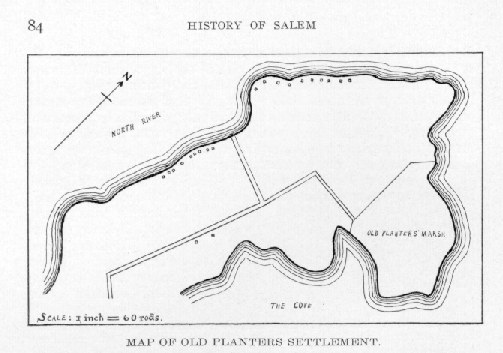
from "The History of Salem", Massachusetts, Vol. I, page 84, by Sidney Perley
My sister, Pat, lives on Planters' Marsh, in Salem, MA. I state "lives on" because, Dr. William Bentley wrote, on March 17, 1801, that while moving soil to Planters' Marsh, from east of Hortons' Point (North River side), they found the foundations of The Dorchester Company's settlement. According to Frances Rose-Troup this is where William Traske, John Woodbery etc. endured their first couple of years living in New England. Perley states, Mr. Conant and his companions removed to the territory called (by the Indians) Naumkeag from Cape Anne in the autumn of 1626. A map drawn by Captain John Smith after 1620 names the spot of the old planters settlement as Bristow (Bristol) - because the inhabitants were from the west of England. In one of the nineteen thatched roofed cottages, which were gone by 1661, was born the first white child of the region - Roger Conant Jr..
Comment:
When one visits Salem, Peabody, and Beverly you will experience the unlimited marketing of the murder of 23 innocent people.
One will not find any trace or marker for;
1. Osmonde Traske's Homestead in Beverly, prior to 1700 - located at the intersection of Colon and Cabot Street in the area of Bessie Baker Park.
2. The first and second landing place in Naumkeag - located by the McKay School on Balch Street in Beverly, MA.
3. The first permanent settlement in Salem - located on the south-eastern shore of the North River and around the corner from Beverly Harbor.
4. Traske's Plain in Salem Village - located north of and along Boston Street, from Peabody Center to Essex Street in Salem.
Click here to view a map (in a window) of where these four places were.
Note;
Prior to 1750, there were at least three distinctly marked burial grounds on Traske's Plain; Gardners Hill Ancient Cemetery, The Friends Cemetery and The Traske Burial Ground. These three cemeteries surround The Old South Cemetery in Peabody, MA. The oldest marked grave in the later is Roger Derby's, who died on September 26, 1698. The only marked Trask graves are those of the family of William, William, John, William, Captain William Traske [bp. 4-22-1744 Salem, MA, d: 11-22-1806]. With all the major excavations that have taken place in that area it is very difficult for me to believe that knowone spotted the remains of "our" family.
Where have the remains of four generations of "our" family gone?
"The Phenomenon of 1692"
One of the laws in England, during the 1500 - 1600's, stated that Witchcraft was a capital offense, punishable by death. In New England prior to "the penomenon" 79 persons were accused, 33 tried and 15 hung for witchcraft between 1647 and 1663.
The problems that occurred in Salem Village (now Danvers, MA) during the years 1692 and 1693 all seemed to have begun at the home of Reverend Samuel Parris in Salem Village. They involved his servant, Tituba, and a small group of young girls under the age of twenty. Tituba was from Barbados where voodoo and the belief in the occult was part of the culture there.
Reverend Parris's daughter Betty and niece Abigail Williams, later joined by Susannah Sheldon, Elizabeth and Alice Booth, Mary Walcott, Elizabeth Hubbard, Mary Warren, Sarah Churchill, Mercy Lewis (Putnam's servant) and Ann Putnam were fascinated with the stories, magic tricks and fortune telling by Tituba.
Ann Putnam, born in Salem Village on October 18, 1679, was the daughter of Sergent Thomas Putnam and Ann Carr. She has been confused with Ann Putnam the first wife of William Trask, son of Captain William Trask. William's wife, Ann Putnam, born in Salem Village on June 7, 1668, was the daughter of Lieutenant Thomas Putnam and his first wife Ann Holyoke. Lieutenant Thomas Putnam was Sergent Thomas Putnam's father. According to the "Putnam Lineage," by E. Putnam, The Putnam Family was very involved with the Witchcraft Trials - in one instance putting brother against brother.
During months of January and February of 1692, nine of the girls started acting very bizarre and were taken before Dr. Griggs for an examination. Dr. Griggs could not medically determine why they were all acting so strangely and believed they were all under the influence of the supernatural.
In March 1692, Magistrates John Hathorne and Jonathan Corwin and Reverend Parris intensely pressured, tricked and questioned the girls, at Lt. Ingersoll's Ordinary in Salem Village, into naming the persons responsible for their fits. By May of 1692 some 200 people were publicly accused by the afflicted girls and hysterical people from the surrounding area.
Governor William Phips, enroute to Salem after James the II was overthrown by William of Orange, arrived in Salem, MA on May 14th, 1692. The Governor set up a special "Court of Oyer and Terminer" composed of seven judges to try the witchcraft cases. The appointed judges were; Lieutenant Governor William Stoughon, Nathaniel Saltonstall, Bartholomew Gedney, Peter Sergeant, Samuel Sewall, Wait Still Winthrop, John Richards, John Hathorne, and Jonathan Corwin.
There were at least 160 people confined in the Essex and Middlesex County jails. Most of which were in chains to prevent the "spectres" from leaving their bodies while they awaited trial. Attorney General Thomas Newton began the first trial on June 2nd, 1692.
From: The Salem Home Page
There are pictures of the grave stones of all the victims and a time line of the events of 1692 and 1693.
The results of the trails were as follows; guilty of witchcraft and condemned to death - hanged, June 10, 1692 Bridget Bishop guilty of witchcraft and condemned to death - hanged, July 19, 1692 Sarah Good, Sarah Wildes, Elizabeth Howe, Susannah Martin and Rebecca Nurse guilty of witchcraft and condemned to death - hanged, August 19, 1692 George Burroughs, Martha Carrier, George Jacobs, John Proctor and John Willard. Elizabeth Proctor was temporarily reprieved due to her pregnancy. Giles Corey was pressed to death for refusing a trial on September 19, 1692. guilty of witchcraft and condemned to death - hanged, September 22, 1692 Martha Corey, Mary Easty, Alice Parker, Mary Parker, John Willard, Ann Pudeator, Wilmott Redd, Margaret Scott and Samuel Wardwell Lydia Dustin, from Redding, was jailed May 2nd in Boston and died there March 10th, 1693. Sarah Warren Prince Osborne, died in a Boston jail while awaiting trial May 10th, 1692.Reverend Increase Mather, President of Harvard College, addressed the court during the trial of Sarah Cole on October 3rd. He stating that the use of spectral evidence should not be sufficient proof for any conviction. Some of the afflicted girls' testimonies, over the period of 10 months, had become inconsistent - the educated public was having doubts. Nathanial Putnam Sr. and 39 other prominent citizens from Salem Village signed a petition denouncing the acquisitions against Rebecca Nurse. Nathaniel Saltonstall resigned from the court in June stating he was dissatisfied with its proceedings. Thomas Brattle, Treasurer of Harvard, wrote a letter to the Governor stating he was against the use of spectral evidence and criticized the witchcraft trials. Governor Phips declare that intangible evidence could no longer be admissible in the trials. On October 29th further imprisonment's were forbidden and the "Court of Oyer and Terminer" was dissolved.
By May 9th of 1693, all the cases had been heard by Superior Courts or special courts of judicature, the remaining accused were either acquitted or pardoned - no one was convicted.
Samuel Sewall, a Judge at the trials, confessed in 1697 to making an error in convicting the accused. Ann Putnam, in 1706, wrote a public apology. By 1710 the families of the accused were seeking recourse from the state for damages and their losses.
The history of the village shows conclusive proof, that, if the matter had been left to the people there, it would never have reached the point to which it was carried. It was the influence of the magistracy and the government of the colony and public sentiment prevalent elce where, overruling that of the immediate locality, that drove on the storm.
Witchcraft in Salem Village Visit this site.
This site was created by the Danvers Archival Center, the local history, rare book and manuscript department of the Peabody Institute Library of Danvers, Massachusetts, with the support of the Electronic Text Center at the University of Virginia. Its purpose is to introduce a major area of Danvers' collections relating to the infamous Salem Village Witchcraft Trials of 1692. This Website is designed to provide accurate general information about these witchcraft events, as well as information on other aspects of Danvers' history.
Richard B. Trask, town archivist for Danvers and author of "The Devil Hath Been Raised" is a one of the consultants.
Buck's Tombstone
In a cemetery on Bucksport's main thoroughfare, clearly visible just inside a wrought-iron fence, is the gray tombstone of Col. Jonathan Buck. Appearing on one side of the tomb is the dark image of a woman's stocking foot, a reminder of an 18th-century curse. During the Salem witch trials, all New England was caught up in the fever to exterminate witches. Colonel Buck, an influential resident and a member of the family from which the town took its name, decided that Bucksport should purge itself of witches also. He found a perfect candidate in an old, feeble woman, whom he had tried, convicted, and executed. With her last breath, she cursed the colonel and declared that when he died his tomb would bear the print of her foot as evidence that he had murdered an innocent woman. Colonel Buck, not one to tempt fate, cautioned his heirs to choose a tombstone unblemished in any way. Soon after his death, however, the shape of a woman's foot gradually began to appear on the marker. Dutiful heirs made many efforts to have it removed, but to no avail. Finally they replaced the stone with a new one. Within a few months, another footprint appeared, it could not be removed. When a third stone was put in place and yet another footprint appeared, the heirs gave up. Today the third stone and footprint remain for all the world to see.
Bucksport is located on State Route 15 and US 1, directly south of Bangor.
 Return
Return
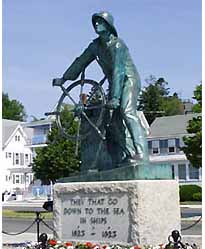
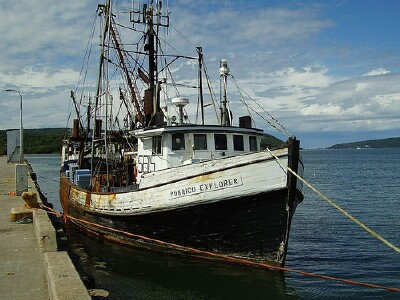
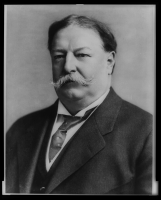


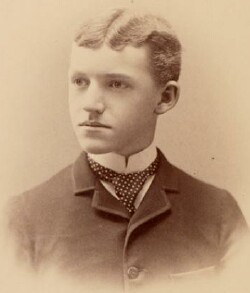
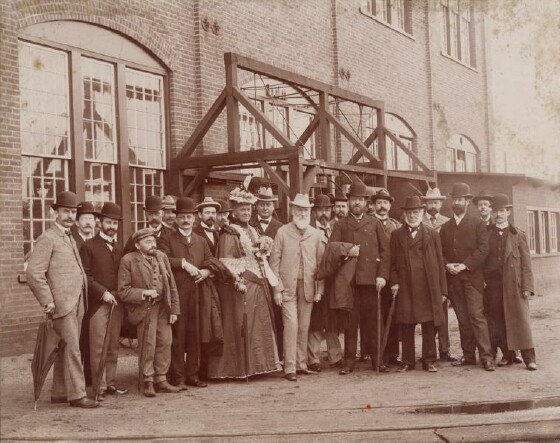 >
>
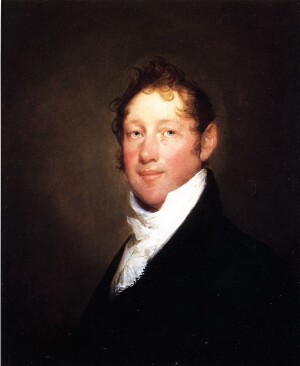
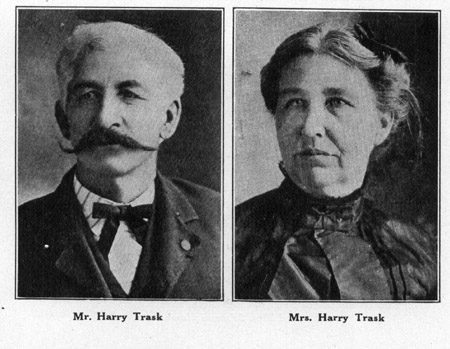

 rwtrask@rcn.com
rwtrask@rcn.com